 HMAS Hawkesbury in 1954 | |
| History | |
|---|---|
| Name | Hawkesbury |
| Namesake | Hawkesbury River |
| Builder | Mort's Dock & Engineering Company, Sydney |
| Laid down | 24 August 1942 |
| Launched | 24 July 1943 |
| Commissioned | 5 July 1944 |
| Decommissioned | 31 May 1947 |
| Decommissioned | 14 February 1955 |
| Motto | "Equality Not Servitude" |
| Honours and awards |
|
| Fate | Scrapped in 1961 |
| Badge |  |
| General characteristics | |
| Class & type | River-class frigate |
| Displacement |
|
| Length | |
| Beam | 36.5 ft (11.13 m) |
| Draught | 9 ft (2.74 m); 13 ft (3.96 m) (deep load) |
| Propulsion | 2 × Admiralty 3-drum boilers, 2 shafts, reciprocating vertical triple expansion, 5,500 ihp (4,100 kW) |
| Speed | 20 knots (37 km/h; 23 mph) |
| Range | 500 long tons (510 t; 560 short tons) oil fuel; 5,180 nautical miles (9,590 km; 5,960 mi) at 12 knots (22 km/h; 14 mph) |
| Complement | 140 |
| Armament |
|
HMAS Hawkesbury (K363/F363) was a River-class frigate of the Royal Australian Navy (RAN). Hawkesbury saw action during World War II. She entered service with the RAN in mid-1944 and was decommissioned in 1955.